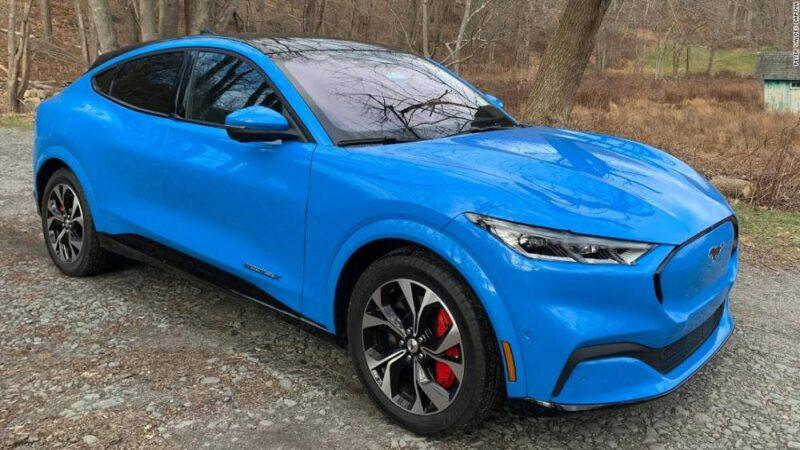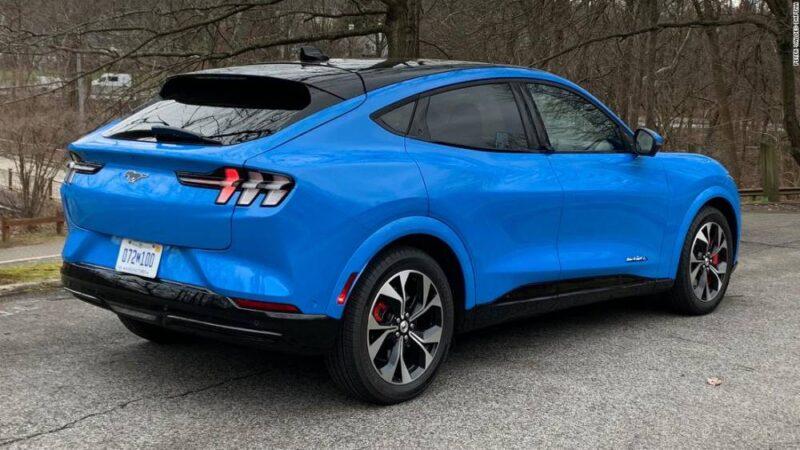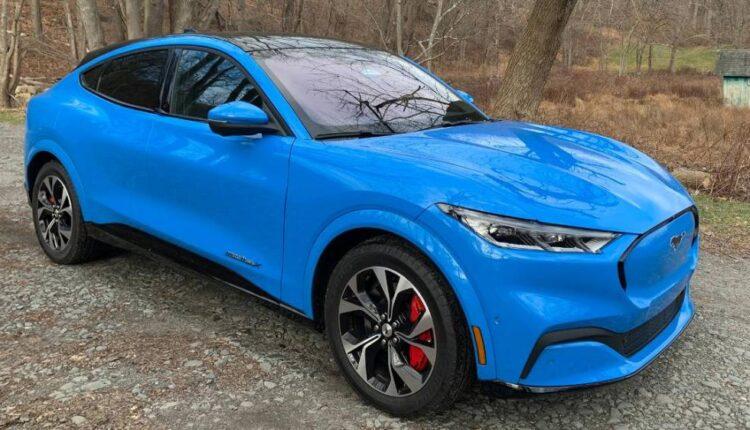(CNN)A lot could have gone wrong when Ford decided to make a four-door electric crossover SUV and call it a Mustang, and even boldly put a pony badge on its nose.
Amazingly, not much did.In fact, Ford’s engineers and designers did a fantastic job of capturing the Mustang’s muscular-feeling acceleration and good handling and packaging it into a vehicle that is not a gasoline-powered, rear-wheel-drive, two-door pony car. It was a massive stretch, and they carried it off.
Even though the version I was driving was a First Edition, not the high-performance Mach-E GT that won’t be available until later, it was so much fun I had to keep reminding myself to take it a little easy — police, you know — just like I do when I’m driving a V8-powered Mustang GT coupe.

The Ford Mustang Mach-E electric crossover SUV in Grabber Blue.The Mach-E can go from zero-to-60 miles per hour in about five seconds, according to Ford, and that seems about right. There are quicker SUVs out there, but that’s plenty quick enough. Driving through a twisting country road, the Mach-E corners nicely. It’s balanced and doesn’t lean to the side too much. The gasoline-powered Mustang coupe handles really well, but isn’t exactly a lithe sports car with ultra-precise steering and the Mach-E shares that personality. It’s a little beefy, maybe, but it can dance surprisingly well. Maybe taking it out on a racetrack would reveal some handling flaws, but especially for an SUV, it felt terrific on public roads.Read MoreIs this a spa? Nope, it's Ford's new F-150 The steering, which gets stiffer and more responsive as you go through the different driving modes — Whisper, Engaged and Unbridled — felt a little numb perhaps, but again not so different from the Mustang coupe’s. The brakes felt good, although I kept the Mach-E set to “One pedal driving” so I didn’t have to use them much. In one pedal driving, lifting my foot off the accelerator slowed the car as if I were pressing gently on the brakes. As I lifted, the electric motors spun, pushed by the wheels instead of the other way around, and the energy they generated that way was put back into the batteries. It’s a common feature on electric cars. In the Mach-E it’s a little clunky at low speeds, often giving a bit of a “thump” as the accelerator pedal is lifted, but it’s smooth and fun at higher speeds. (The low speed clunkiness may be reduced with later software updates, a Ford spokesman said.) The 346-horsepower First Edition Mach-E I was driving had a base price of $50,000, not including a $7,500 federal tax credit. The First Edition models are already sold out, but all-wheel-drive Premium models offer the same performance at a slightly lower price. Prices for lower-powered versions start in the low- $40,000 range. The 480-horsepower Mach-E GT will be available later with a starting price of $60,500.

The Ford Mustang Mach-E provides respectable practicality while still being as enjoyable as a Mustang ought to be.To Mustang shoppers used to a 460-horsepower car with a V8 engine costing $36,000, those prices might seem out of line. But this is an electric crossover SUV with optional all-wheel-drive, four doors and seating for five. In terms of price, range and power, the Mach-E is clearly targeting the Tesla Model Y and Ford’s aim is pretty good. The Tesla Model Y Long Range goes 326 miles on a charge and Tesla claims the same zero-to-60 acceleration time as the Mach-E for the same starting price.The Mach-E does have a few problems, though. For one, the exterior door handles — or exterior door buttons — seem pointlessly high-tech and fussy. I understand having nice, smooth buttons saves a smidgen of aerodynamic drag, but I’d still rather just a grab a handle and pull to get into my car.Also, as good as the Mach-E is, there’s still one area in which Tesla still has a big advantage. Tesla maintains a huge and easy-to-use network of chargers. Ford has its FordPass app, which allows access to lots of other electric vehicle chargers, even more than Tesla has. But there’s a big difference between an EV charging network and a bunch of different chargers you can use. Tesla’s chargers are consistent in their design, making them easy to find, and they’re consistent in how they work. And they do almost always work. Ford reveals an electric Mustang Mach-E SUV with 1,400 horsepowerEven with the FordPass app’s help, chargers were often tricky to find partly because I wasn’t sure what I was looking for. Also they could be confusing to connect to. Chargers from different companies work with the app differently. In some cases, using the app wasn’t needed to start charging the SUV. In other cases, it was.
Most people who buy a Mustang Mach-E, just like most people who own a Tesla, will have a charger installed at home, and that will easily handle their charging needs most of the time. Publicly available chargers are a convenience to enable long trips. But they offer peace of mind to those thinking of buying an EV and based on my experience with Tesla’s chargers and (so far) Ford’s, the advantage remains with Tesla.As far as the SUV itself goes, though, Ford scored big on that part. The Mustang family should be proud of its newest member.
Source: edition.cnn.com

